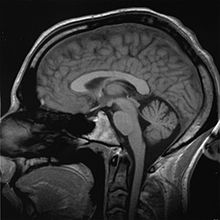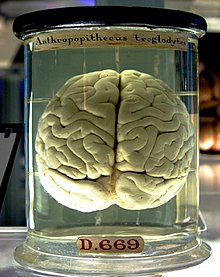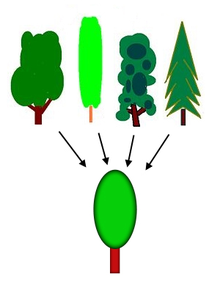User:Aldughaishem ahmed/sandbox
Methods in Cognition and Brain
[edit]Introduction
[edit]The brain of any animal is the most powerful part of the body‘The human memory can therefore be regarded as the engine of entire human and animal’s body as it controls and coordinates all the activities and functions. This is according to (Sakarya, 2007)It is also responsible of the feelings that are experienced.Cognition, which is highly correlated to brain activities, refers to a collection of mental activities such as ability to learn and understand language, reason, solve problems, attention, ability to make decisions and also memory[1] .


Cognition finds its study in different areas of knowledge such as cognitive science and also in psychology. It is simply understood as the ability to acquire and process information. This makes it highly related to the idea of intelligence and the state of mind. According to researchers,‘process of cognition can either be unconscious or conscious and artificial or natural and are highly studied in a variety of fields especially in neurology’.(Cognitive neuroscience) is adiscipline that scientifically tries to understand the biologica substances that are concerned with cognition and also the creation of cognitive functions by the human brain. Cognitive neuroscience finds its application in methods such as electroencephalography (EEG),Electrocorticography and Magneto encephalography (MEG).Recent developments in the field of medicine and research have led to the creation and application of a large number of imaging techniques of the body of humans. Different electro-biological instruments regarding to the stomach, brain, muscular contractions and heart have all been developed with a sole aim of simplifying man’s life playing a major role for his existence. Study of cognition and the human brain has been made possible with these advances in medicine and more so due to the introduction of computers and their technology.

The recording of electrical activities throughout the scalp from end to end is referred to as electroencephalography. This is an imaging medical technique that reads the neuronal activity produced by the several parts of the brain. The method is absolutely non-invasive and also does not use life threatening techniques and machines such as the x-rays. It can be applied over and over to the sick, normal adults, and children with absolutely no risks or limitations. It is therefore friendly and has no health implications in the near future Electroencephalography measures fluctuations in voltage which are as a result of ionic flows of current inside the neurons of the brain. These alternating (spontaneous) neuronal activities are recorded within a given time span usually (20 to 30 minutes). The recordings are normally made from a multiple of electrodes and conductive media that are positioned on the surface of the human scalp[2] .
Origin
[edit]The history behind the development of Electroencephalography can be trucked back to 100 years down<br

the line to the famous Swartz and Richard Caton, (1842–1926). He discovered the presence of
the electrical currents in the brains (cerebral cortex) through his experiments on rabbits and monkeys which he used as his experimental animals. (Sakarya, 2007). Though his findings were not that satisfactory, they were advanced by Hans Berger, (a German physiologist and psychiatrist). Berger, with his efforts in continuing with the
work done by Caton, made it possible in the present time to register the electric potentials in human brain He devised electrodes in the form of small metals placed on his subject’s scalp and with simple radio device(galvanometer) he was able to make the recordings of his findings. The device made it possible to amplify the neuronal electrical activity (which were relatively small) emanating from the brain. In his observations,

the activities tended to change with regards to the brain status like inadequate oxygen, sleep, being alert and<br when relaxed. This was the most profound invention of the time, an invention which was described "as one of the most surprising, remarkable, and momentous developments in the history of clinical neurology".The discoveries of Hans Berger were later affirmed by Adrian and Matthews in 1934. All these evolutions marked the precursors of the modern medical electro – encephalography[3] .
Method
[edit]According to (Blomberg, 2011), the electric activity of human brain usually starts during the late prenatal period and it is believed that at birth all the neural cells are fully developed to full number. According to neurologists,the brain is divided into three parts which are the brain stem, cerebellum and the cerebrum. According to (Finger, 2001)


the cerebrum has a layer on its surface called the cerebral cortex which remains by far the largest region of the central nervous system. It is said that “cerebrum has a number of regions for the expression of behavior and emotions, movement initiation, conscious awareness of sensation and complex analysis. The highest influence to encephalography comes from electric activity of cerebral cortex due to its surface ”position”. Encephalography directly measured from the cortical surface is referred to as (electrocortiogram). Scalp recordings of randomly neuronal activity in the human brain, electroencephalography (EEG), makes it possible for recording of potential changes within a period of time between a signal electrode and a reference electrode. ‘The electroencephalography (EEG) system is comprised of electrodes, amplifiers (with appropriate filters), and a recording device for recording band frequencies’. The scalp is prepared by removing the dead skin through a light abrasion minimizing resistance as a result of the dead cells of the skin A number of numerous small pieces of electrodes are then placed on the surface of the scalp and connected to the input of the amplifier. This is according to Teplan. (2002). in his book “FUNDAMENTALS OF EEG MEASUREMENT “. The voltage between the signal electrode and the reference electrode is then amplified. During the recording process, a number of activation procedures may be used. Procedures used include closure of the eyes, lack of sleep and sleepiness, alertness and being drowsy.Neurologists note that, ‘only large number of active neurons is capable of producing electrical activity that is recordable on the surface of the head’. Electroencephalography (EEG) is very sensitive to a large number of states including state of stress, sleep, and alertness. With varying administration of stimulus, a range of frequencies of neural activity are recorded[4] [5] .
Relative Advantages
[edit]Relative Advantages There is a large variety of techniques used for brain study includingmagnetoencephalogrphy and Electrocorticography.Despite electroencephalography (EEG) having less (poor) spatial resolution, it has a large number of advantages over other methods. Its sensors are usable in many areas as they are less bulky and highly mobile. The technique also allows movement of the subject while other neuroimaging methods limit this. It also has the greatest advantage of speed and allows for study of auditory stimulus since it is silent
Relative Disadvantages
[edit]Electrocorticography produces low spatial resolution on the scalp and also determines poorly the neural activity occurring below the upper layers of the brain. The method has prove to be time consuming as it takes a lot of time in placing the electrodes around the head and connecting the individual to the electrocorticography (EEG).
References
[edit]- ^ Sakarya. "A post-synaptic scaffold at the origin of the animal kingdom". 2007. Retrieved 7 December 2013.
- ^ Benjamin, Files. "An introduction to EEG Neuroimaging workshop". 2011. Retrieved 7 December 2013.
- ^ Finger (2001). The brain in antiquity. Origins of neuroscience: a history of explorations into brain function. Oxford University.
- ^ Teplan, M (2002). "FUNDAMENTALS OF EEG MEASUREMENT" (PDF). MEASUREMENT SCIENCE REVIEW. 2. Retrieved 7 December 2013.
- ^ Blomberg (2011). "Concepts of cognition for cognitive engineering. International". Journal of Aviation Psychology. 21: 85–104.
{{cite journal}}:|access-date=requires|url=(help)
